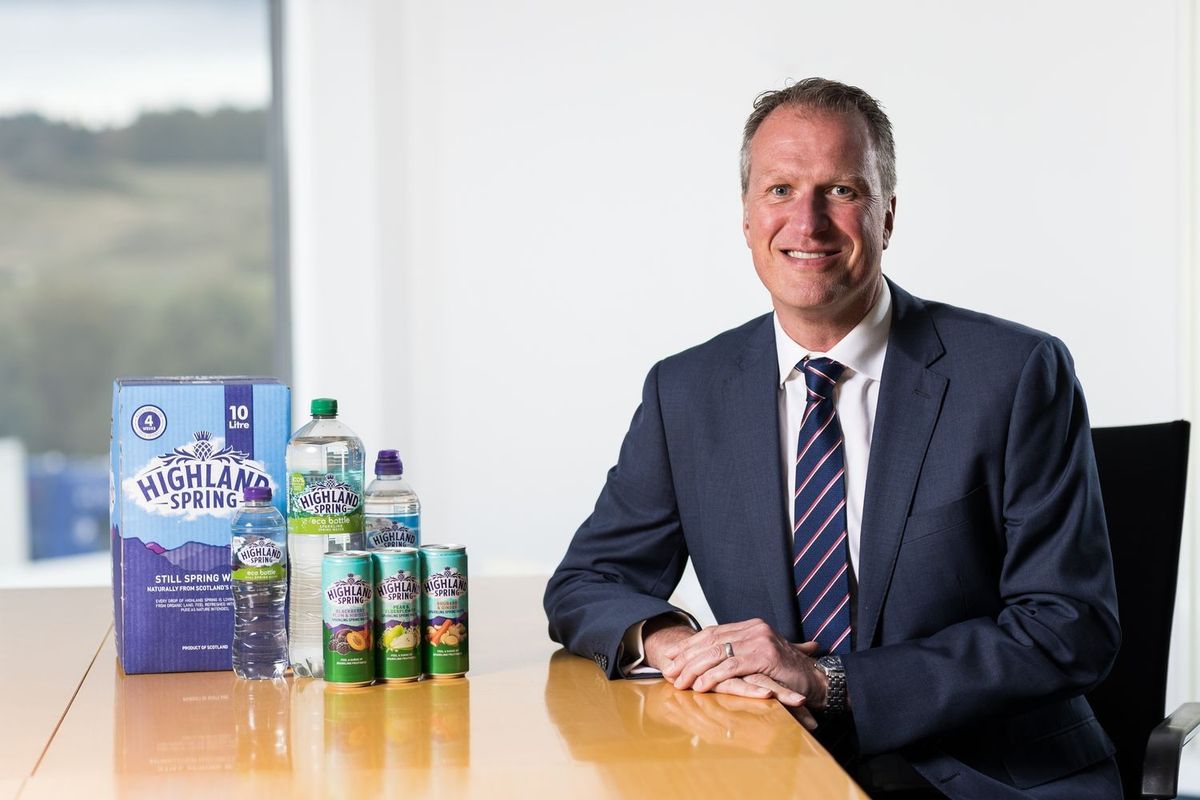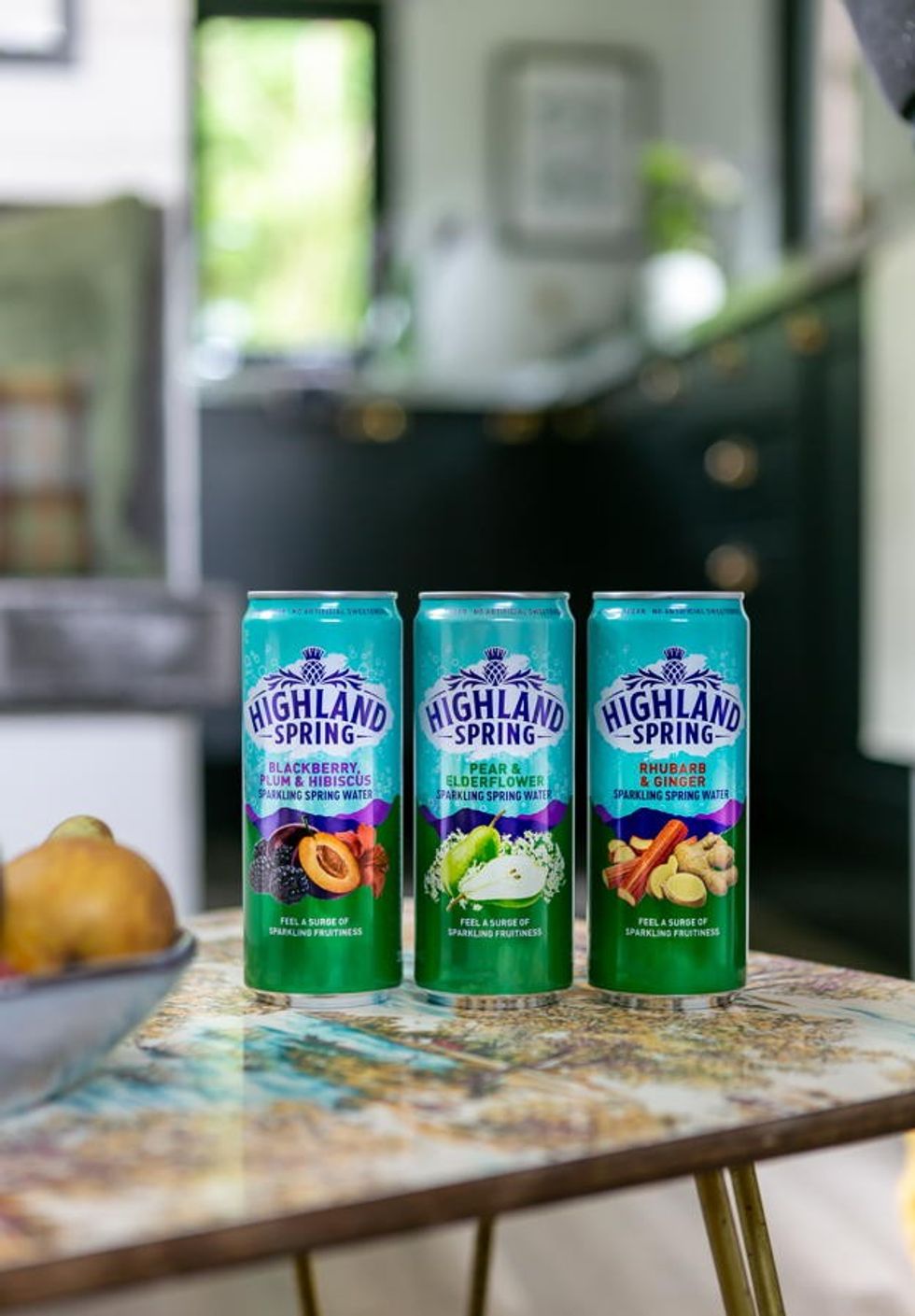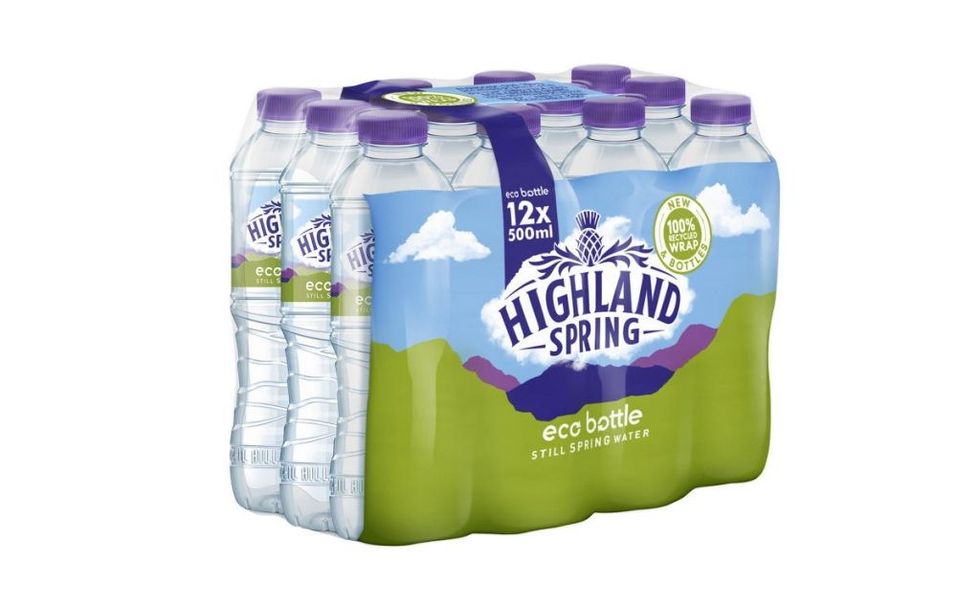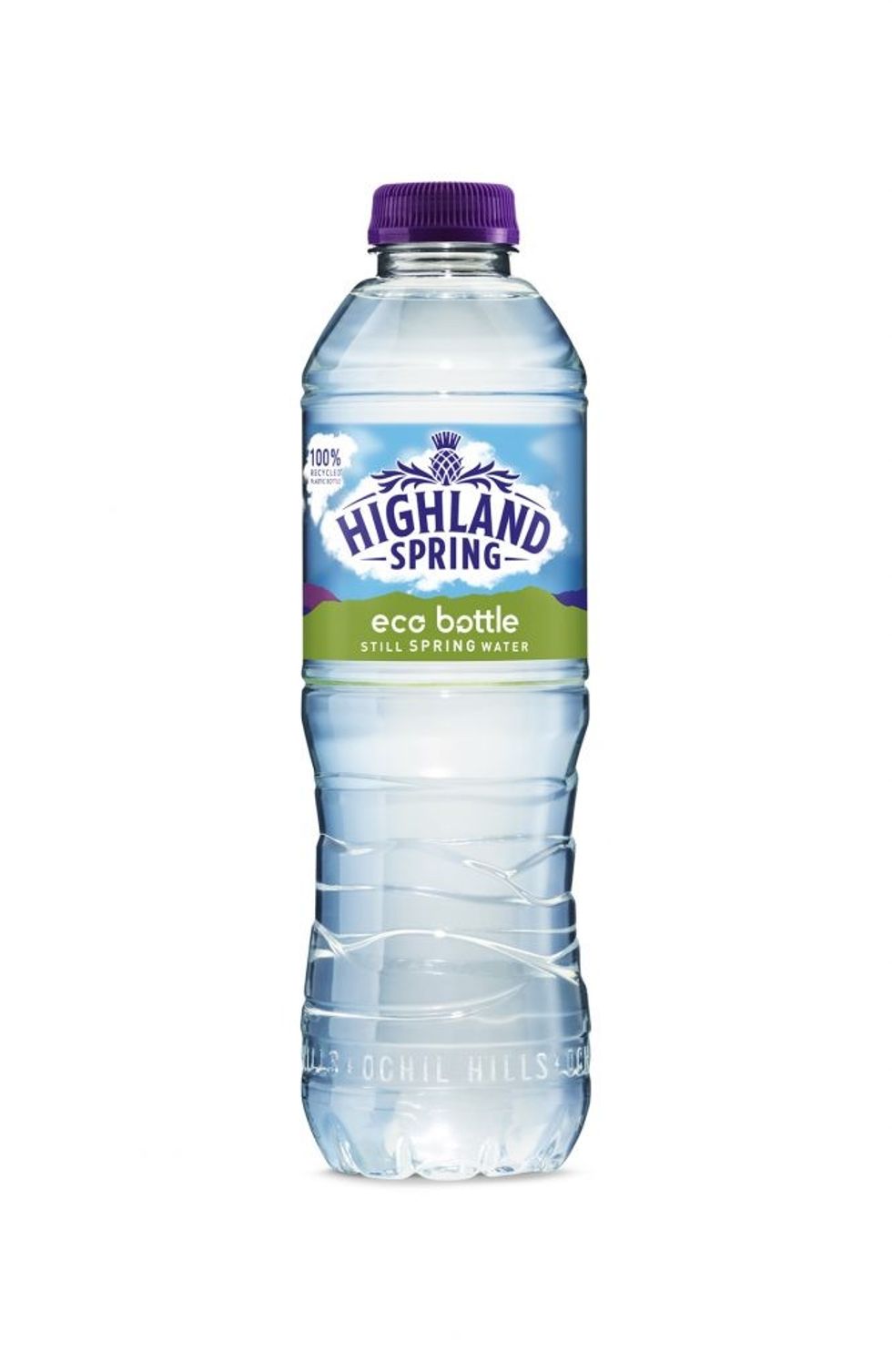Highland Spring is a brand that does what it says on the bottle, and it starts with the name. Some water brands are synthetic – given an identity and an image by a big corporation and sold as an authentic natural product – strictly speaking, true, because it’s water after all. But Highland Spring really is water from a highland spring and nowhere else, specifically from its Scottish base in the often-snow-capped Ochil Hills, right next to Gleneagles. The land is kept free from any kind of pollution, pesticides or habitation, guaranteeing that the water is as pure as nature intended.
Not only the official water of the British tennis since 2009, Highland Spring was also the first bottled water brand in the UK to have its catchment area certified as organic by the Soil Association.
As this pedigree illustrates, there is a lot more to water than you would think, especially for the Convenience channel, where vast lakes of it are purchased by thirsty punters. The sector is sparkling and is multifaceted – and increasing in volume all the time, and especially where the sparkling version is concerned, as Simon explains.
So exactly how parched is the UK right now?
"Water is doing very well, says Simon. “During lockdown, people's habits changed and you saw them consuming at home and not on the go, no surprise there. And as a result, the format they bought changed into big bottles – and also, at lunch, they started buying sparking a lot more than even before.”
The larger lockdown pack sizes (making virtue of necessity for some supply-strapped categories) were almost the emblem of the pandemic – big sizes of stuff carted home and enjoyed with other “inmates”. But what is the situation now?
"As we’ve come out of lockdown, and things have eased up, what you've seen is that the back of store – the multipacks, the big retail packs – have pretty much stayed at the previous level. But people have started buying the on-the-go and impulse bottles again, too. I think people have changed their mindset, health and wellbeing has become more important.”
Incremental sales, then?
“Shoppers are still buying the products for home, but they've started buying again back on the high street. Penetration levels are up. And unlike most of soft drinks, water is growing. In the four weeks until the end of May, volume – not value, because that is obviously distorted at the minute – but volume was up 4.5 per cent. Water is holding up really well and it's across a wide range of formats. All the impulse skus are doing well, your 500ml, 750mls. Back-of-store packs are also holding up especially the 1.5 litre, because people are getting used to having a bigger bottle on the go, rather than one small bottle.”
Does this good news hold true for sparkling water as well?
“Yes,” says Simon decisively. “Sparkling is the one that had a real boom when we entered lockdown. And the opportunity now in impulse is to latch on to that change in consumer behaviour. Consumers have changed, but when I look at the offerings, particularly in independent retail, they haven't changed, and sparkling water remains a disproportionately small part of range – and, consequently, of sales.”
Perhaps it is because sparkling is still seen as a special occasion or mealtime drink, retailers are not ranging it as aggressively for on-the-go shoppers – when actually they should do, because the nation became hooked on sparkling during lockdown and wants to drink a lot more of the bubbly stuff now they are out and about again.
On brand
Water is in a very good position as the product is totally non-HFSS. It is also a deceptively simple product. Yes, water comes out the tap, but producers such as Highland Spring have educated us to value it much more as a concept and as a taste – and as a brand of course. So how do you approach selling a commodity as a branded product in all these different channels and expand it and make it more attractive and profitable and valuable – and in a soaking wet country?
“We start off with the point of view that we don't see water as a commodity.” Simon explains. “It's a different product, a natural source product. It's the healthiest beverage on the shelves. It's also got the lowest carbon footprint of anything on the shelves. But ultimately, people buy water because they know they should be healthy, and they want to be healthy.
“Yes, it’s a bit about convenience and aspiration, but ultimately, people like the taste. So, if you compare a natural source water to something out of the tap, it's the same as me saying it's a barista coffee, versus instant. And people that like coffee would say there's no comparison, it's not the same drink, I would say source water is not a comparable to tap.”
Simon argues that if a shopper goes into a store to buy water and it's not there, they are not going to ask the storeowner for some water from the tap, they're going to either buy a soft drink, buy a caffeine drink, or walk out.
“So, it's not an alternative to tap,” he concludes. “People want it because they value the taste, value the brand, trust the brand.”
He says that a lot of what makes the brands successful in water is trust. They trust that they are pure: “They trust that the taste is always consistent and good. And they trust them because of where they come from and over years and years that's built up from brands like ours, demonstrating where the product comes from, the fact it's natural, the fact it's not treated – we do nothing to it.
That reputation takes a long time to build up. “There's many brands that have tried and failed over years to launch, sometimes with a really big investment,” says Simon, referencing the corporate water failures. “You can't just launch in this market and become an overnight success. You've got to earn that market share by earning the trust of the consumers and that's why you know year on year we focus on what we do and what we do well, whether it's around our provenance and where we come from or making sure that people recognise that it is healthy, it’s not treated. There are no calories in it.
Part of the appeal of the Highland Spring brand runs directly back to the source and where it comes from – the beautiful, unspoiled Ochil Hills.
“We don't add anything, we produce it sustainably, and it's a product that has a low [carbon] footprint,” Simon says, and this makes the most of the locale and artisanal frame for the brand. “In terms of marketing, you go for the traditional.”
Could there be a problem with water with the NPD aspect, though? Marketing is hyperactive these days but there's only so much you can do with water. How do you grow and stay visible in the impulse channel?
"There's many parts to that," he replies. “Your packaging itself is important – making sure it's up to date and it's fresh and appealing. Your marketing campaign must reach consumers outside the shop, and the depot obviously influences that. But you're always trying to come up with new thoughts or ideas. Two, three years ago, were the first to bring out a bottle made from 100% recycled material. That was innovation. And we led the market on that. We launched last year offering cans, and that was a first for us both in terms of the product format and adding a flavoured range to our portfolio.
“Then we brought out our 10-litre hydration pack and subsequently a five-litre, so innovating a whole different packaging format for a different consumer occasion, meeting different need states, and for people who want a product that keeps fresh for up to six weeks, that you can put it back in a car if you go to a festival or you're going camping, or actually you just want something on the edge of the desk or on the kitchen top that's fresh and really easy for access and convenience. We've got many ways in which to innovate, other than just the liquid itself. We've always been mindful of that.
Sparkle and flavour
It was over 40 years ago, in 1980, when Highland Spring proudly held aloft its first product off the line. I ask Simon how far he thinks Highland Spring has got with the total addressable market. Customers are plainly thirsty for this highland spring water, but because it has to come from there it's perhaps restricted to the mainland UK in terms of logistics and price
“You have to bottle at source,” says Simon, “so the UK is always going to be by far our largest and biggest property and 97 per cent of our sales are in the UK. But we're not a regional brand, we are across the whole UK, and there are certainly channels where we have huge opportunities. I talked about independents and sparkling, and we've definitely got opportunities in Convenience around high street independents, symbols, on-trade, food service – there's enormous reach for us still to go at. We're far from saturated.
“If you look at the market data, we've got by and large a 15 per cent market share, so we've still got 85 per cent to go for!” he adds, laughing.
A big thing about the impulse channel is that it sells chilled, in contrast to supermarkets, which obviously helps in the summer. Does he see seasonal growth can push further into that?
“Definitely, and I think good retailers always recognise it and will tweak and change store layout, the non-fixture secondary space, whether it's outside the front of stores or within, depending on the locations, and they'll put different things in the chillers at different times of the year. But what I would say is this,” he emphasises: “Sparkling water is definitely best served chilled. People drink sparkling because they want refreshment. People want still because of the hydration. And they're very happy having still served at ambient temperatures.
So there is a particular merchandising science to selling more water?
"What you find is as temperatures go up, there are different points where you see changes happening in behaviour and purchases. As you get to about 21 degrees, you start to see a real upturn in sales of soft drinks generally. You get to 24 degrees and it goes into overload. Then you get to 28 degrees and then water takes off while some soft drinks fall back again, and it's all about real hydration. At 28 degrees they don't mind if it's chilled, they literally just need the hydration. It's not about refreshment.”
Does it affect brand at that point? Do people then just go for quantity over quality?
“I think that changes,” Simon answers. “If it's really hot, and they can't buy one brand, their brand allegiance is going to change. But generally speaking, people buy into brands with water. The fact that there are some really strong bands is because people have either very strong loyalty, or they have a small repertoire of brands that they will buy from but rarely outside of that.
What's your ongoing strategy for increasing Highland Spring sales in the Convenience channel? Are you going to keep pushing the flavoured waters?
“Definitely. We're learning from it, we're working, we're committed to having NPD as a driver, I think it's the right thing for us, it's the right thing for the category, so we will be bringing out more flavours.”
But chilled sparkling, though, is a whole bunch of sales sitting waiting to happen?
“There are still areas where increased distribution and visibility are still opportunities for us. There's still a long way that we can push the brand both in still and sparkling as well as new areas. We've just launched our five-litre hydration pack and that's been out now for just a couple of months. That’s another avenue that we'll be pushing.”
Highland Spring is going full bore on this, supported by a fresh TV campaign on Channel Four and Sky, building on last year’s. “It's a mixture of focussing on our sustainability credentials and our eco product, as well as focussing on provenance and where it’s from, and it's on the platform of being your natural self.”
The campaign sees the brand partnering with celebrity Fern Cotton. “She has become a real lifestyle guru. We're partnering up with her around our five-litre launch, to encourage people to be drinking more water. People should be drinking eight to 10 glasses a day and they're not – far from it.”
Recycled, recyclable
I remark that the terms of trade seem to be in Highland Spring’s favour. The artisanal, the local, the natural, the healthy, are all on trend, and the fruit-flavoured waters are very specific, curated products and localities to keep that precious identity.
“It has to feel like it comes from Highland Spring,” says Simon, “that's a point of uniqueness for us.”
The other facet of the local and the original and being in tune with nature, of course, is the brand’s eco-credentials. Highland Spring was the first to launch a 100% fully recyclable recycled bottle, so they are being as eco-conscious as possible, but it’s not always easy.
“There's a lot of education required and I hope people understand the difference between recycled and recyclable. Our packaging has been recyclable for as long as I can remember, PET is one of the most recyclable materials. But yes, the product we launched a few years back now was the first bottle made from recycled content. That was a breakthrough.”
Simon is rightly proud of the brand’s pioneering achievement, but he knows recycling also depends on DEFRA and local councils to get their act together to make sure the recycling system actually functions.
“In terms of how we ultimately get to a closed loop,” he says “which I think is what you're referring to, the thing that's imminent in Scotland is the launch of a deposit return scheme (DRS) in August next year [2023]. We've been very heavily involved with that from the start and we are very supportive – it's the right thing. There is a deposit return scheme that will come to England following that, but don't know quite when.”
The fear is that well-meant bureaucracy will undermine eco-progress: “Our hope and aspiration would be that when [DRM] does come to England and the other parts of the UK that it becomes a single system, because there's complexity around having different products for different parts of the UK. That's not good for anyone,” he concludes.
There is also the question of conserving fossil fuels. Simon doesn’t think EV batteries for haulage are there yet (“And they're very expensive. But that's like everything else, that's just the NPD cycle. Over time the availability will come, people will invest, and then then you get critical mass and scale”).
Then, of course, there is the ongoing truck driver crisis – although it has prompted an eco-solution up at Highland Spring.
“One thing that we've done that helps us slightly is, we've got a rail siding on site that launches in August,” he reveals. “That means that we are able to put a huge amount of our vehicles on rail from our factory essentially down into the centre of England without the use of lorries. We have already put a lot of our product on rail, but we still had to take it from our factory to a railhead. The new siding will take that away. The environmental benefits will be huge as we're removing 8000 trucks a year, removing 3200 tonnes of CO2 a year, so great from that perspective, but it also helps in de-risking us: the more we put on rail, the fewer drivers we need. I think rail is an obvious alternative.”
Really?
“Environmentally, it's the right thing to do. Future-proofing is the right thing to do.”
Water everywhere!
Growing the category – sparkling, bug packs and flavours in cans –should be the priority of every independent retailer, argues Simon.
“Make sure you got the biggest lines,” he stresses. “Availability is crucial for both retailers and wholesalers, so make sure you've got enough. Make sure you make it from the centre: it is growing as a category, so make sure you're really putting it in people's faces and you're bold and making water visible.
The example that I talked about with sparkling is an easy opportunity that anyone can pick up on because it is incremental: if you're if you're not doing it today, then that's a subcategory there ripe for the taking. But I think coming into the summer season, it's about availability. Make it prominent and follow good retail disciplines; and make sure that you've got the key skus and items from the biggest brands.
Where is best?
“Make sure you've got it in chillers but don't only put it in chillers,” he answers. “The first thing I'd say is make sure it has its fair share of sales. It's the old rules: you've got to make it so that there’s easy access. So, front and centre. What you do find with water is a lot of people buy water ‘and’.”
He points out that some retailers will sell fresh coffee and some people will then buy a coffee and a water. “The energy drinks or the shot drinks – people will buy them and a water. It's not one cannibalising the other: there's opportunity to expand the total sale in the shop. don't minimise it, thinking, ‘I want to sell more high value stuff,’ because the opportunity is there for both.
“And watch the weather forecasts. If it says it's going to be hot in a week's time, don't wait till the day before. Make sure you've got water in.”








